Yves here. Many, including many readers, have been keen about the idea that global population levels will stall out and hopefully decline, and with it, reduce resource demand. This article contends that the transition may result in even higher commodity consumption.
By Pedro Naso, Postdoctoral researcher Swedish University of Agricultural Sciences and Timothy Swanson, André Hoffmann Chair Geneva Graduate Institute (IHEID). Originally published at VoxEU
In the coming century, the global economy will experience an unprecedented convergence of two trends, as the world’s population reaches its peak while simultaneously approaching near-zero levels of growth – a combination that will invert both the population pyramid and dependency rates. This column examines this transformation within the context of changes to the global economy’s fundamental methods of production. High levels of dependency and the relative scarcity of labour may induce a shift in the methods of production from labour-based R&D back to a reliance on natural resources.
The global economy is going to pass through a severe population problem over the coming century, resulting from the simultaneous peak in global population levels with near-zero population growth (Roser et al. 2013, Giovanni and Tena Junguito 2023). This conflation of world firsts is seen in Figure 1, which shows that global population is projected to reach a peak of approximately 11 billion individuals in the year 2100, at the same time that population growth is forecast to be moving asymptotically to zero.
Figure 1 World population growth, 1750-2100
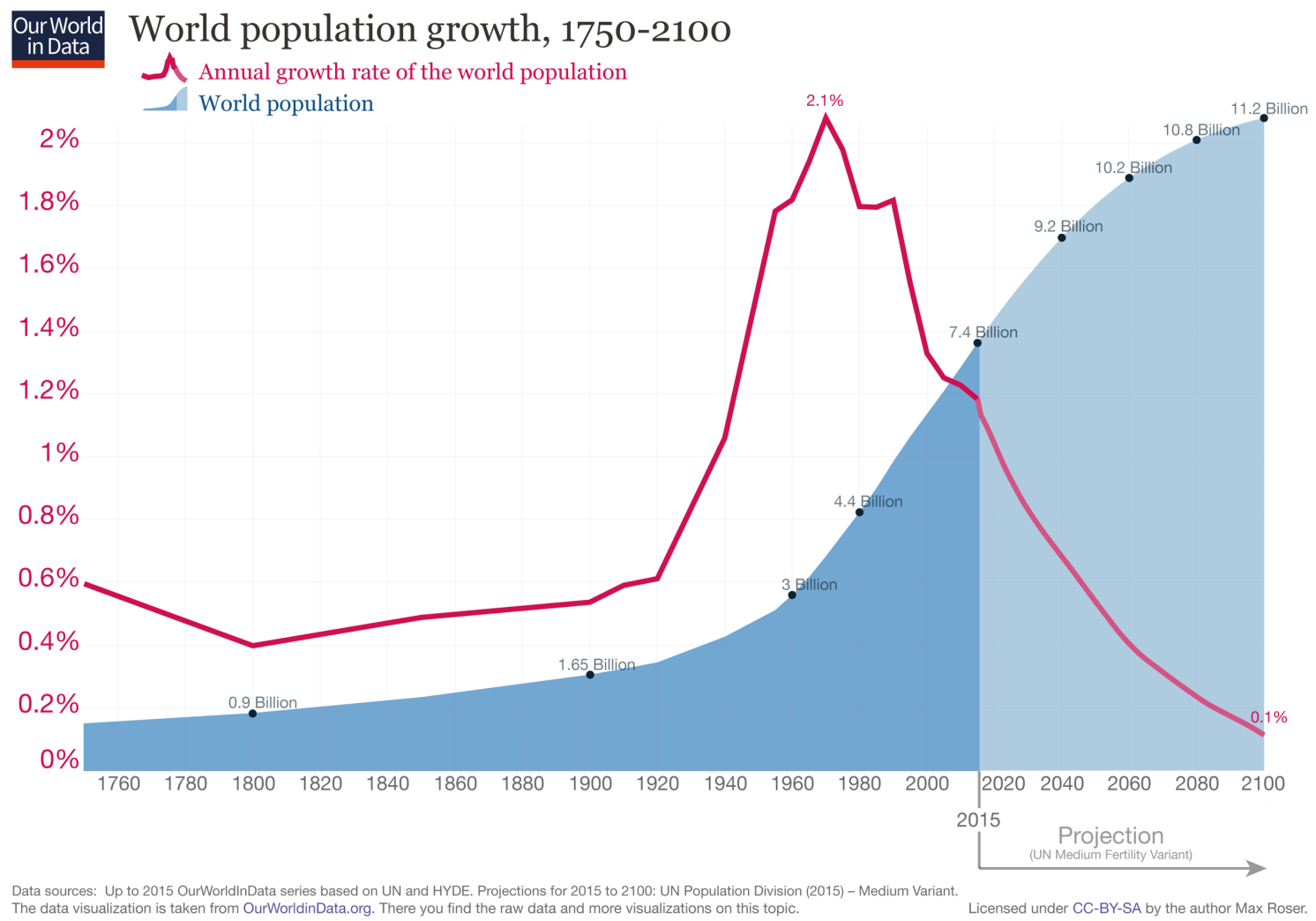
The important consequence of this coincidence is the comparative inversion of the population pyramid, as the incoming cohorts of young people progressively diminish relative to the size of previous cohorts. The impact of the inversion is captured in the concept of an increasing ‘dependency rate’: the proportion of the population over 70 years of age relative to the working population. Over the past half-century, this proportion of dependents to workers stayed below 10%; in future, it will grow to 30%.
This is seen in Table 1, in which the UN projects global dependency rates rising to previously unseen levels (UN 2015). It is remarkable how stable the dependency rate has been over the past half-century, fostered by ongoing growth in population in many parts of the world. The precipitous decline in global population growth since the 1960s reverses this outcome, with sub-Saharan Africa and South Asia the only regions of the world forecast to avoid rapidly declining population growth rates in the near future. In certain parts of the more developed world, the dependency rate is forecast to approach 40–50% (Aidt and Swanson 2020). What does this change portend for the world’s resources? What are the important changes in store for the world economy?
Table 1 UN dependency rate forecasts
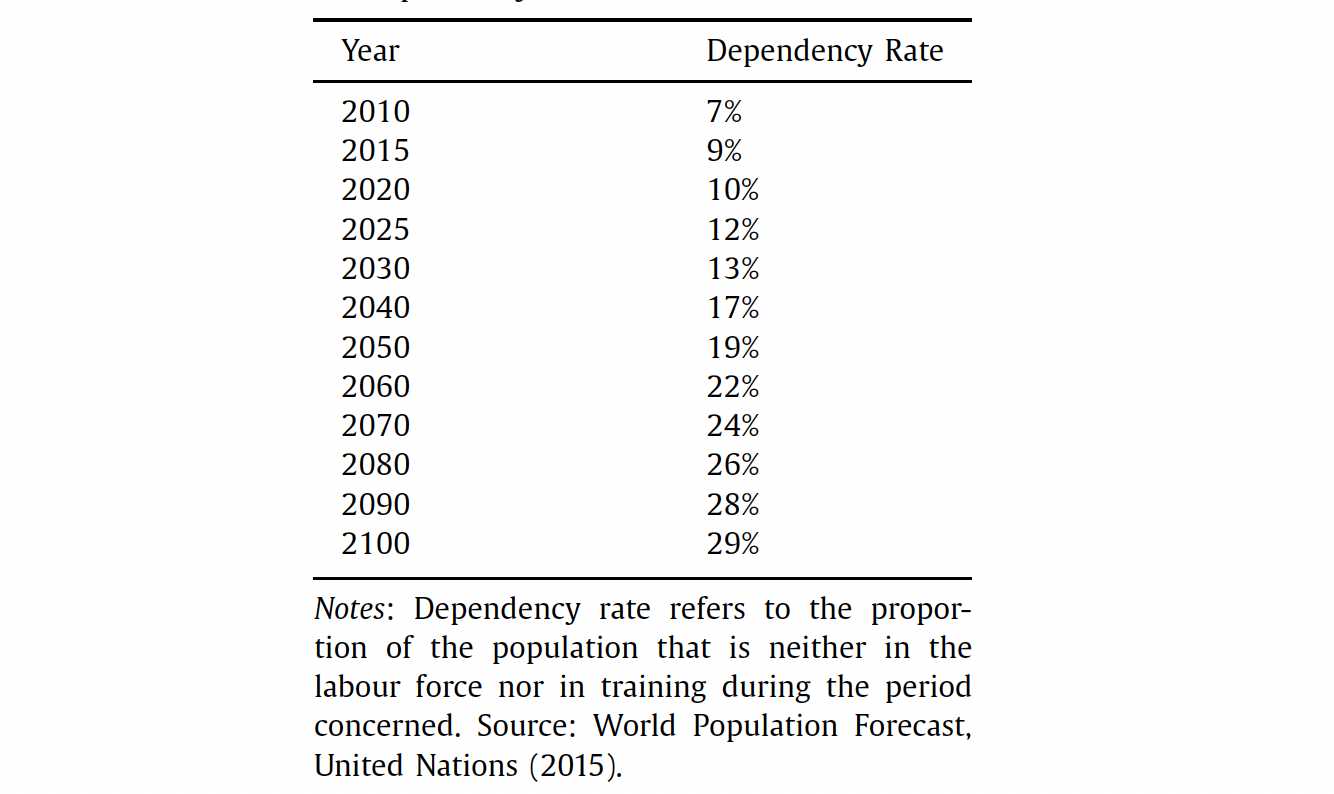
In a set of recent papers, we and our co-authors have been investigating the potential consequences of this demographic inversion in regard to its impact on global resource scarcity, using the case study of land scarcity for agriculture as our context (Lanz et al. 2017, Naso et al. 2020, Naso et al. 2022). Malthus of course hypothesised in the 19th century that demographic factors would drive future food scarcity. More recent hypothesises suggest that the silver-lining of this reversal in population growth might be a new era of reduced pressure on global resources. In our series of papers, we investigate this hypothesis in the context of an integrated assessment model combining and integrating the growth in land use, food consumption, population growth, technology, and standard economic production. We find that there is good reason to be concerned about how population growth interacts with resource pressure.
Our MAVA model builds on the endogenous growth models of Galor (2011), and integrated assessment models such as Nordhaus and Boyer (2003), but focuses on issues of food and resource (land) use together with those of population, production, and technology. In the MAVA model, the use of land, labour, and capital is necessary to produce the food by which the population is sustained; the resulting labour pool is then allocated across six sectors (agriculture, production, education, land maintenance, and R&D). The combination of these six sectors produces an integrated production model that is then fit to observed variables over a 50-year timespan, 1960–2010. The model’s fit to historical data (see Figure 2) demonstrates that all of these observables have moved together relatively smoothly over these five decades.
Figure 2
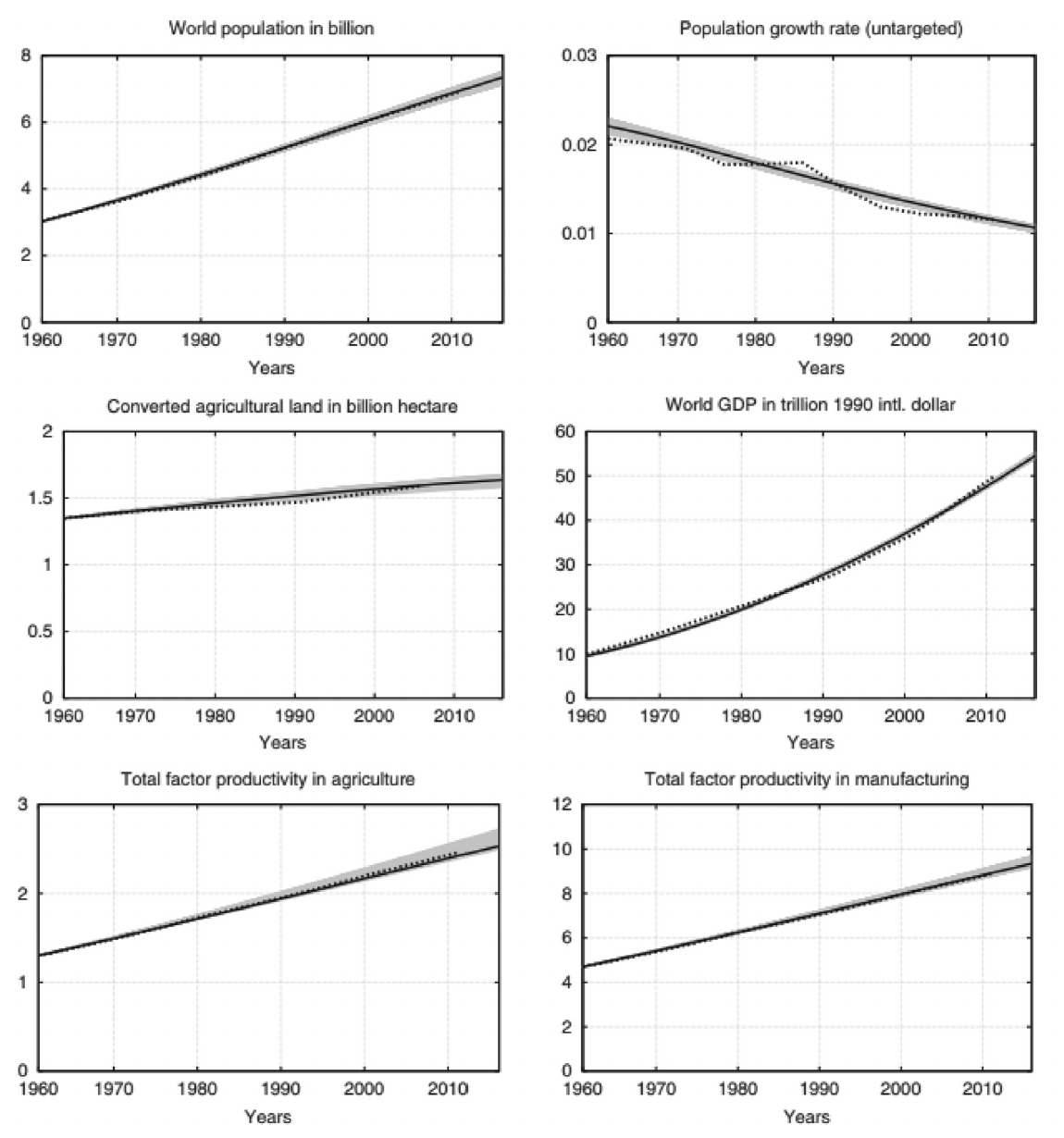
Interestingly, the most notable difference between the performance of these sectors over these five decades lies in the decreasing rate of resource use (i.e. land in agricultural production) relative to the expansion in the global population. Although population increased by a factor of three (from about 2.5 to 7.5 billion) over this 50-year period, the amount of land in use in agriculture increased by only about 10% (from about 1.4 to 1.6 billion km2). The reason that food and population could grow at such a rate while the growth in land use slowed lies in the growth in total factor productivity in agriculture, which increased by a factor of more than two.
We deduce from this that the main reason that Malthus’ prediction of population-driven food scarcity has proved inaccurate in the past is the fact of technological change in agriculture, which enabled technology to substitute for resources. In the case of agriculture, it is estimated that there is a fixed stock of about 2.1 billion hectares of arable land on earth, so the rapid population expansion over the two centuries since Malthus’ prediction incentivised the substitution of labour-based methods of production for these fixed resources. The agricultural R&D sector would have been one of the labour-based sectors that was so incentivised.
We can envision how this resource-augmenting process might have played out if population growth had not begun to slow in the 1960s. In Figure 3, we see that the forecasted increase in land use in the 21st century would be about 10% compared to a near 100% increase in global population. Although technological innovation becomes increasingly costly to produce in our model, the R&D sector continues to generate resource-augmenting technical change into the future, assuming the demographic structure remained constant.
Figure 3
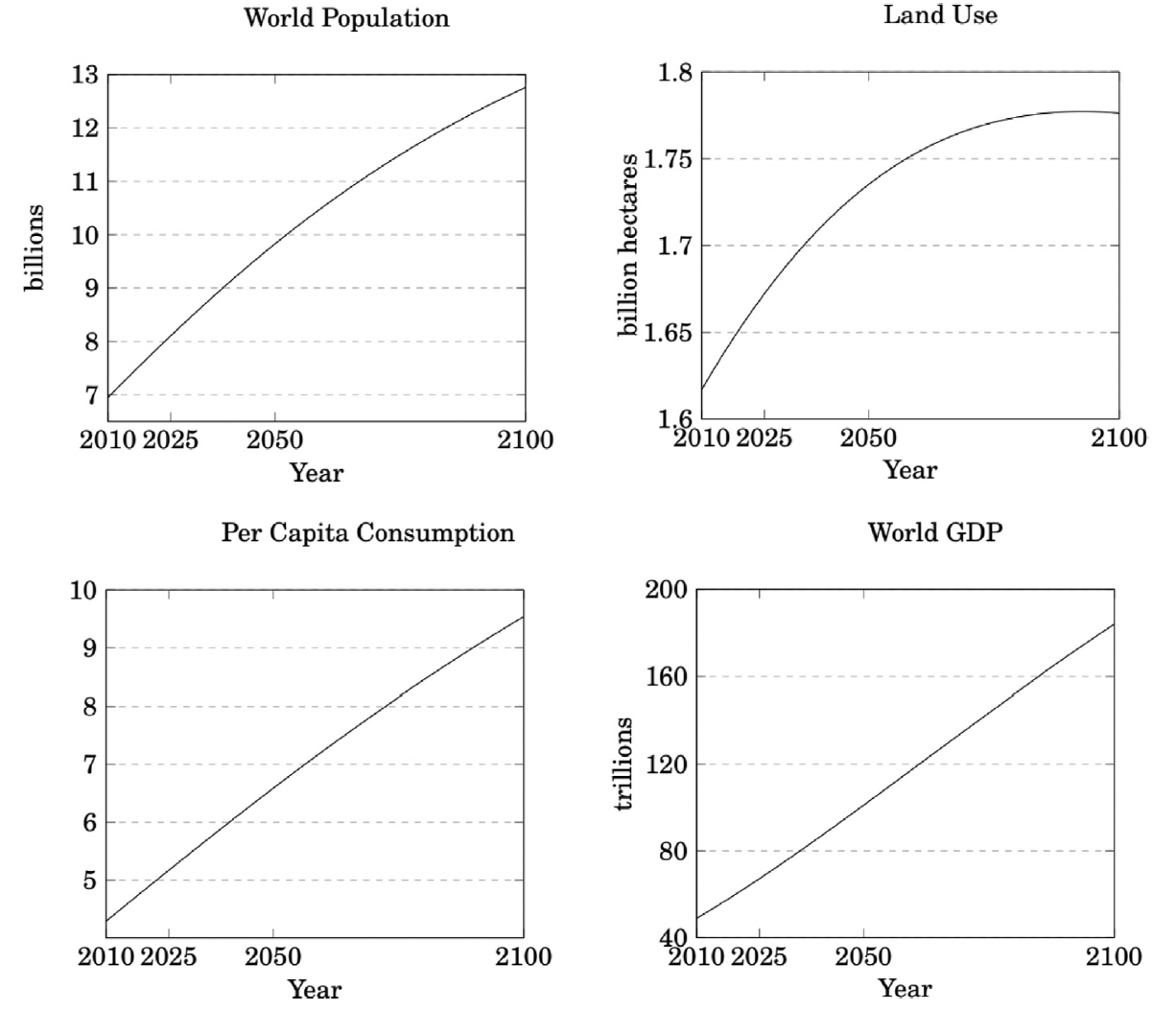
So, how does a resource problem arise when we assume increased dependency rates? It arises because the decline in population growth is indicative of a general decline in growth across the economy. As in all endogenous growth models, MAVA’s forecasts are particularly driven by the increasing cost of children’s education, the impact of this cost on population growth, and its implied increase in dependency rates (altogether labelled the ‘demographic transition’). But when the population sector is integrated with other sectors of the economy (as in MAVA), this demographic transition is seen within a gradual slowdown in growth across all major parts of the global economy: food, land use, capital, consumption, and productivity (Figure 4). The entire system is moving in a very different direction than in the past, as observed across the economy in the years since 1960 (Maestes et. al. 2023).
Figure 4
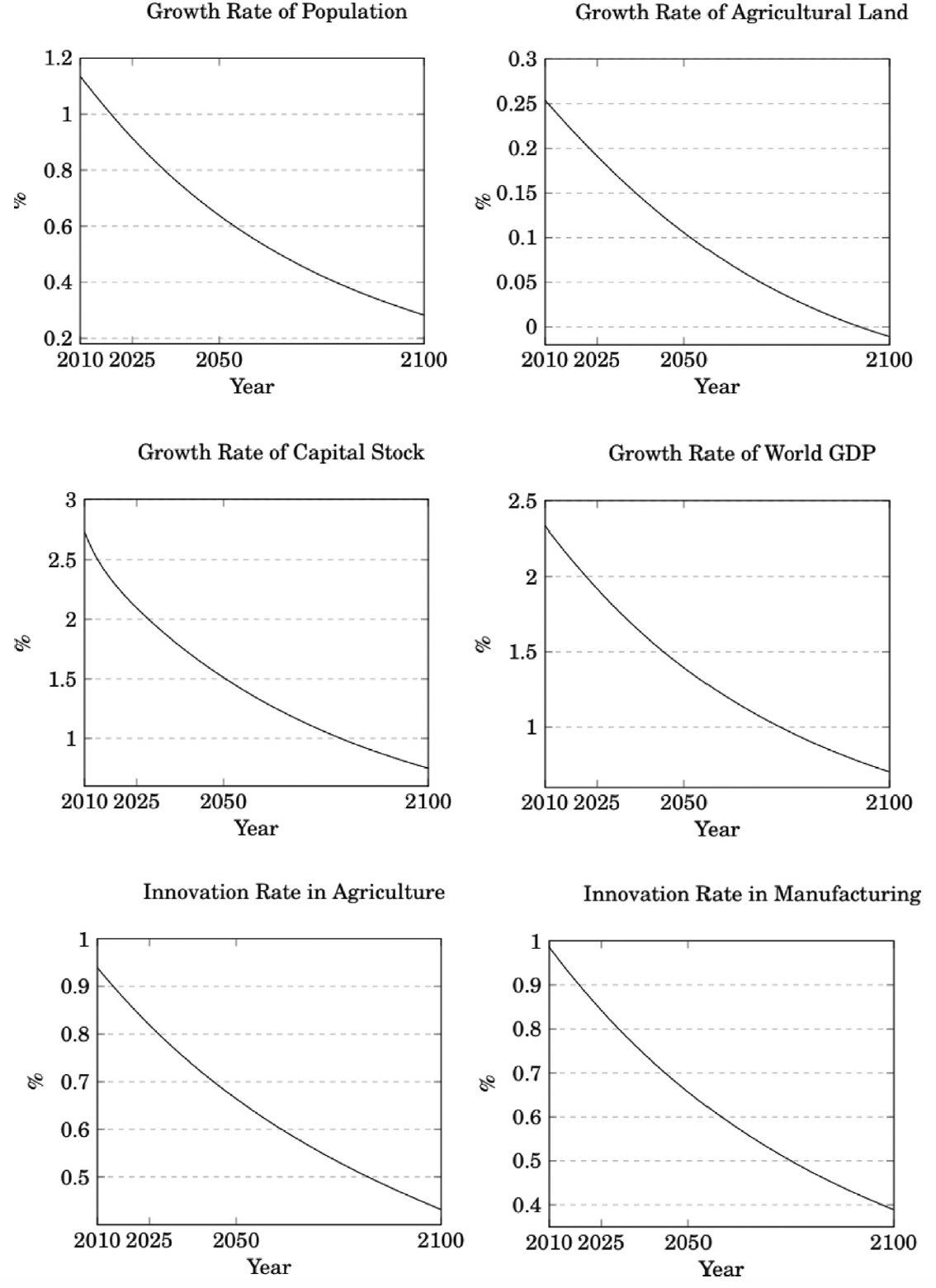
What does this change in direction imply for resource scarcity? Resource scarcity has been less of an issue over the past two centuries of population growth due to the increasing prevalence of labour and the relative low cost of education-enabled R&D-based production methods. A future with a high cost of education and resultant lower growth in the work force implies revisiting those choices regarding the preferred methods of production, relying less on labour-based R&D and more on resources. The future goes back.
How this occurs may be seen in the MAVA forecast set out in Figure 5, in which the economy’s labour market allocation is simulated under conditions of both the long-standing dependency rate (i.e. about 7%), and the now increasing rates (i.e. towards 30%) set out in Table 1. The shifting out of the dashed lines in Figure 5 demonstrate the sectors in which greater labour allocations occur, principally in agriculture, agricultural R&D, and increased land use. The labour share in the remainder of the economy remains relatively unchanged (general R&D) or falls somewhat (education). These changes in the economy demonstrate how the economy is shifting away from its previous reliance on R&D in advancing growth in production, and back towards the natural resources on which it once relied.
Figure 5
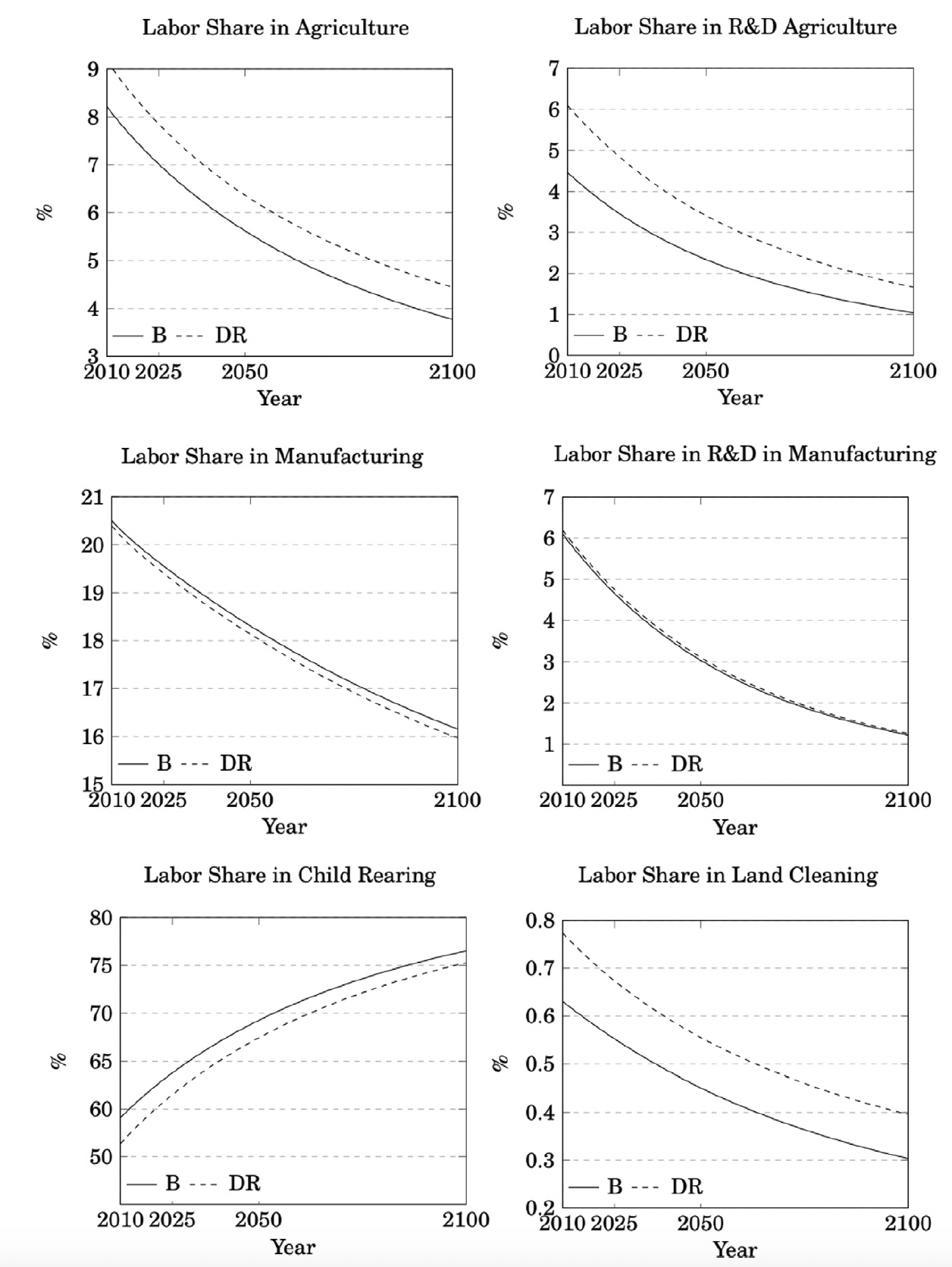
In Figure 6, the striking impact of increased dependency is summarised: it shows that the main effect of increased dependency is an increase in the relative resource intensity of the economy with little impact on the economy otherwise. At base, all of these phenomena are being driven generally by the coming era of increased dependency rates. But the specific consequence of this change is a relative shift in emphasis away from technology-based production methods and towards more resource-based methods of production. Hence, increased resource scarcity will turn out to be a consequence of lower rates of population growth rather than higher levels of population.
Figure 6
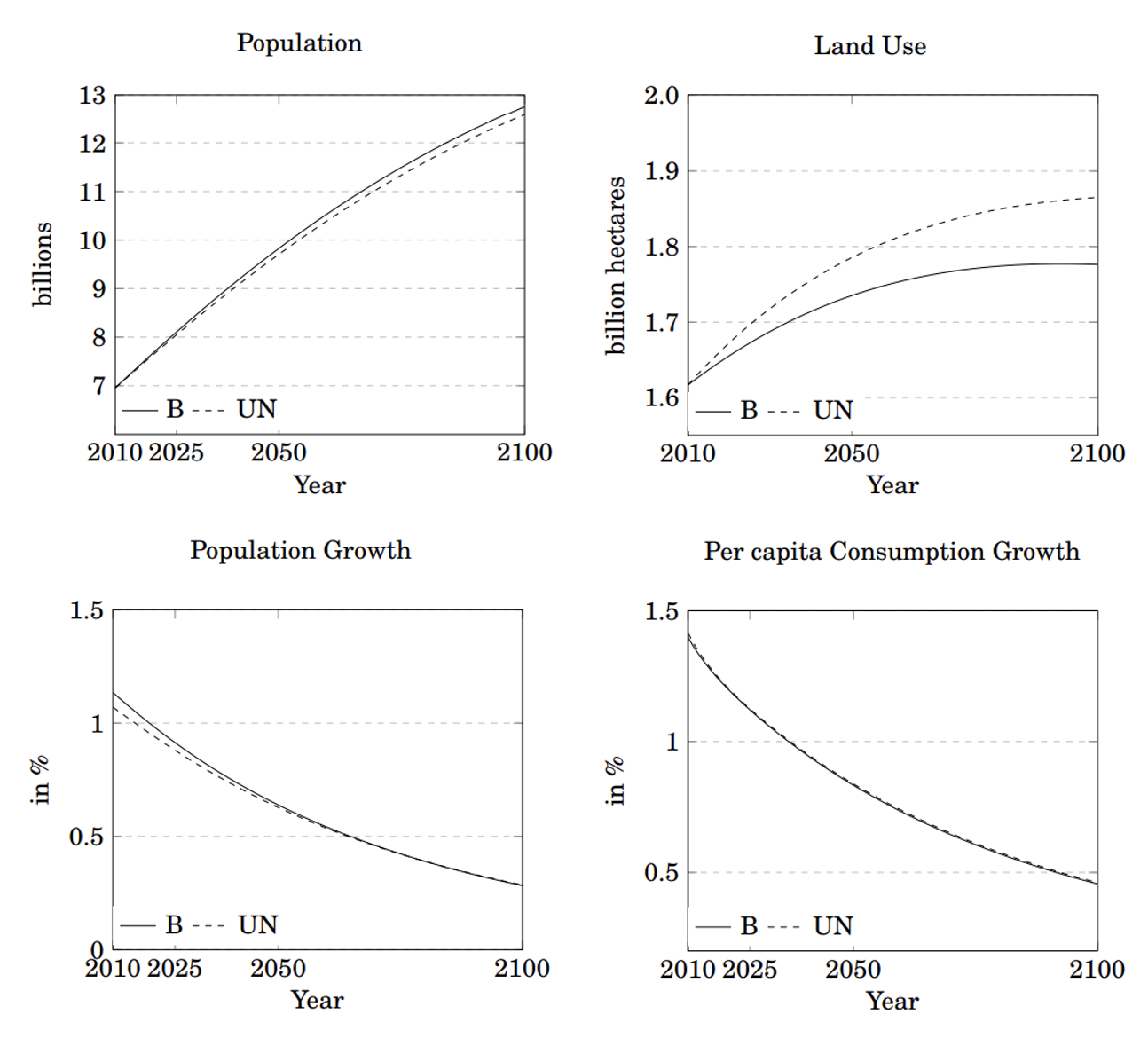
In short, the coming century contains a population problem that should be of great concern because of the ongoing momentum that will cause global population to crest just as global population growth hits its nadir. This means that the resource scarcity problem foreseen by Malthus will become most severe just as the technological solutions provided in the past become most costly to produce. Ironically, the population problem foreseen by Malthus is one where declining population growth rates may be the primary reason for substantial increases in global resource scarcity.
Authors note: The authors wish to thank the André and Rosalie Hoffmann Foundation for their long-running support of this work, and the MAVA Foundation for its role in administering the Human Niche project. We also wish to thank the long list of co-authors, collaborators and colleagues on the project over the past dozen years, who receive individual notice in the authors lists and acknowledgements in our papers listed below.
See original post for references


The argument is that as overall population grows, the rate of growth declines, leading to a shortage of younger workers to support society. This leads to substituting technology and increased resource usage to compensate for loss of younger workers labor, thus leading to faster resource depletion. He’s looking out at trends over the next 80 years.
My guess is that physical resources, including the ability of the environment to absorb further abuse (including global warming), are already so depleted/degraded that “the Jackpot” will occur/is occurring in the next decade or sooner, implying a global population collapse much earlier than 2100.
The author’s error is in projecting business as usual far into the future.
I’m trying hard to not let my eyes cross looking at the chart that says global GDP will go up 4X in the next 75 years.
The word “energy” is to be found nowhere in this analysis. Progress in agriculture is assumed to derive from a process “which enabled technology to substitute for resources” — except that agricultural technology essentially shifted its dependency from the resource labour to the resources energy (mostly oil, for running agricultural machinery and producing pest control substances) and minerals (for fertilizers and incorporated in all the steel machinery).
Besides, the authors build upon the work of Nordhaus and Boyer, referring to the their opus “Warming the world” (2003) — which has been thoroughly dilacerated by Steve Keen (as reported in this very site) as methodological nonsense.
I am therefore extremely sceptical about the utility of a macro-economic model inspired by invalid approaches, and from which decisive factors are absent.
Perhaps a lower-growth population will have unexpected detrimental effects on agricultural production (but then I would tend to think this would affect labor-intensive production in developing countries first, not highly mechanized industrial agriculture in the West), but I doubt this article helps us understand why.
The remarkable discovery relating population [young population] and resource scarcity described in this post suggests a purely local solution for dealing with resource scarcity in Europe. Europe just needs to bring in more young immigrants and compel the emigration of retirement age older adults. Resource scarcity problems solved. The MAVA model will demonstrate how this would work. Worry no more the clever VoxEU economists ‘have this’. Send them a fat research grant and there is no telling what other problems they might solve.
Look at that population growth curve! Unprecedented.
How did humans accomplish this insane upward growth without all starving? By the exploitation of natural resources to create fertilizers and to move water. Are these natural resources replicating themselves at the same rate as human beings? Is climate change going to accelerate water scarcity?
Even if growth levels-off at some point or even collapses we are building on a base that exceeds the planetary carrying capacity. Consideration of the growing proportion of humanity who are “dependent” is an excellent framing but it has a certain IBG/YBG feeling to it, pushed out to 2100.
Out of left field but 20 years ago no one would have imagined an 81 year old woman on the cover of the Sports Illustrated swimsuit issue. Yet with an aging population and some changes in social mores, here we are.
I’m far from impressed by this article. Starting with the premise that the more people there are, the better the growth, they build a model that shows their premise, and use the recent past where growth and more people correlates to validate their model. An actual model would be causal, not correlational. E.g. something based on physics (energy into the system, resources into the system, etc).
We’re living at a time where fossil fuel usage is being repressed. The reason we could grow more food on the same land is because of fertilizers derived from fossil fuels. Production of fertilizers in the EU is reduced due to the greatly higher cost of natural gas from the US that replaces the Russian natural gas that is banned due to sanctions due to a war we provoked (see Mearsheimer). People like Kerry and Rutte say they want to reduce the number of farms “to improve the environment” (eg 3000 in the Netherlands, banning farmers from ever working again on a farm in the EU). A lot of farmers in the US are old and have no one to take over. Secondly the top soil of some of those 1.6 billion km2 is being exhausted, and unless we improve our practices, will be lost. So, if anything, food production and productivity should be expected to fall, which means fewer people.
Similarly, we’ve exploited many of the cheaply accessible minerals, and now must mine less rich veins. That means more energy use. The main energy source used for mining is fossil fuels, but we don’t want to use them (and extracting them costs more energy these days). Therefore we can expect fewer resources to be extracted.
Notice that I’m predicting fewer people and fewer resources, but not because of some magical correlation, but because both people and resources depend on the amount of fossil fuels available.
However, there may be a way to break this cycle: get mineral resources on asteroids, if that turns out to be energetically viable. Send up one nuclear powered mining robot (expensive to get out of the earth’s gravity well), get it to an asteroid (using a solar sail), mine the asteroid and accelerate the minerals back towards the earth. Very involved, but perhaps economically feasible one day. Elon Musk’s self landing rockets make such endeavors easier to consider.
So the only salvation is to keep growing “ad infinitum”, is that what this author is saying? Egads!!
Did the authors of this piece include rising crop yields due to the increase in carbon dioxide in the atmosphere?
I’ve read that for every degree of warming food production declines 10%
I think the problem here is that an economist used a model and a bunch of assumptions to make predictions – quelle surprise.
Here’s my “model”. There’s one apple tree that on average produces 100 apples per year and there are 100 people living nearby. Everybody gets one apple. Fast forward several years and the tree is still there but there are only 50 people. Now everybody gets two apples. If my 95 year old self is too decrepit to climb the tree to pick an apple, I’ll knock a couple down with a stick.
Leave it to an economist to unnecessarily complicate things in an attempt to prove that we need groaf forevah.
So, gasp! The profit ponzi no longer works when there are scarce exploitables. Who could ever have imagined such a tragedy? Clearly we must change our attitude about aging. It’s simple, everyone over the age of 60 will be expected to pony up for a more expensive retirement. What else? Never mind that the elderly are not an infinite resource either. Their relative wealth of savings will disappear pretty fast. And then what? The thought that humans will have a big temper tantrum and refuse to be enterprising producers because there isn’t any profit in it, “it’s just a big waste of time,” is pretty absurd when the only alternative to living sustainably – that is without exploiting the environment or each other – is a long torturous decline of civilization. I’m not really worried. We’re simply not that suicidal.
I get the “OMG, how will we keep having billionaires vibe” too
I agree with the above criticisms on the lack of energy use in the models and the use of models by those like Nordhaus, which are junk. Steve Keen wrote a paper titled, ‘The appallingly bad neoclassical economics of climate change’, which just crushes Nordhaus’ work. Nordhaus (winner of the Nobel memorial prize in ‘economic science’) assumes things like most economic activity won’t be affected because it occurs indoors. He also does an analysis of average temperatures around the world and compares them to the economic activity in the corresponding region. He then says when a region warms its economic activity (GDP) should move toward the GDP of the corresponding temperature region in the previous climate. His ‘damage curve’ estimates on the effect of increments of warming on GDP are mostly the ‘expert opinion’ of other economists, not physical scientists. And on and on. Nordhaus’ work is indeed ‘appallingly bad.’ I would include the link, but when I do my posts do not appear.
Work by more biophysically oriented scientists on the economy, like Charles Hall, show an almost 1:1 correlation with economic growth and energy.
I also think the dependency rates are suspect. We are clearly at the beginning of the Jackpot. We got an example with Covid. I bet many years have already been shaved off life spans in a large portion of the population based on the accumulating evidence of long term damage. And as abundantly chronicled on this wonderful site, the neglect, incompetence, and corruption of government and elites generally has reduced that ‘dependent population.’ I fully expect similar behavior in the future. And then there is pollution, low sperm counts, etc, etc, I expect population to peak lower than this estimate.
I continue to be one of the readers that looks to low birth rates with hope. More low birth rates and less Four Horsemen please.
I agree with all of the above criticisms of the article and would add that even if we could take its conclusions at face value, it seems that our beloved leaders have solved the population problem. By promoting mass murder of the old and infirm, they might be able to shrink world population (denominator) to the point where even with producing fewer workers (numerator), you still get a large enough population growth rate to drive their simple model of economic/productivity growth while shrinking the dependency ratio. So do your part for our beautiful economy and get infected today!
Argument is based on the most magical number in economics: GDP. That’s all you need to know.
I’m waiting for Dems to launch full nuclear war against anyone and everyone, and declare that they’ve solved both global warming and population growth.
Just to be clear, team GOP would launch full nuclear war for other reasons, mostly Biblical.
They can do better by releasing a new “gain of function” special from a lab, which has the added benefit that the death toll can be very selective, depending on how well the virus was designed.
What is arguably the greatest increase in living standards in history followed the Black Death which killed half of Europe.
Tradesmen did better, farmers did better, per capita productivity soared, and if you believe James Burke in Connections people became so well off that they started wearing underwear, and the bone man, who collected bones for fertilizer, became the rag and bone man, and the disposed underthings became paper, leading to an early information revolution.
Color me dubious. We have historical examples of population decline, and the post-decline times are almost universally good.
This analysis is utter drivel because all the charts rely on purely economic metrics. As someone else mentioned energy consumption or production is not mentioned, neither is raw physical material throughput.
Everything is measured in dollars or relative and self-referential dollars. If I charge $1 for a kilo of flour, and then change the price to $2 and manage to sell it, “productivity” has doubled according to economics, but you haven’t magically produced another kilo of flour.
The Bible is more rational in its economic analysis than whatever this is. Mainstream economics should be regarded as a religion. And as others mention anything even flirting with Nordhaus should be treated with immense skepticism. In a sane world Herman Daly would have the “Nobel”.
Feeling particularly stupid this morning, maybe result of day spent hauling water to prevent peas, onions and leeks from drying out, in 82 degree temps. Hey, we’re in western NY and it’s May! We are not used to this! And, then dancing in the evening. (Peasants got to have some fun!)
But, the beginning paragraphs, which state that we are experiencing the convergence of ‘two trends;’ world population reaching its peak and simultaneously reaching near zero levels of growth. Ummm ….. isn’t the former a result of the latter? So … don’t laugh at me. Just explain.
And, stalling GDP. Assuming that GDP is in any way a meaningful measure of human achievement and happiness, (rather than the absurd yardstick of capitalist greed.). Just add in the now unmeasured ‘care’ hours; those endless hours of child care, household management, elder care, development and maintenance of community and neighborhood social bonds, etc. Without which, we might add, civilization as we know it, would crumble. Mostly.
It’s gonna be another hot dry day, here in Chautauqua County. The water buckets are filled and the spouse is ready to drain the bath tub from yesterday’s wash-up. We use gray water here, because the well tends to go dry if we use it to water the veg.
So if there is more people, we get scarcity.
And if there are less people, we get scarcity.
Economics. If we built airplanes using this as the “science”, airplanes could fall out of the air and kill millions, and people would insist that something is wrong, but it’s economics, so economists get to shake their heads and say those people just didn’t believe enough or something equally inane.
Agree with all the arguments re model based thinking above…..
But how did they get to be post-docs (ie PhDs), and be able to say “This conflation of world firsts …. global population is projected to reach a peak …, at the same time that population growth is forecast … to zero.” and then call this a “coincidence”!?!
They’re the same thing!!! Literally! This is high school level calculus.
By definition, the peak has to be at exactly the same time as the rate of change goes to zero.
Embarrassing is what it is.
When I see an article with charts prognosticating far into the future, I know that something else will happen.
Thanks for all the great comment. Generally speaking, any article this long is not worth reading!
It is heartening that Naso’s short article meets with general disapproval. It is symptomatic of mainstream economic thinking to support an egregiously wrong theorist like Malthus — even while admitting Malthus was wrong.
Reflecting the influence of Malthus, one of the major axioms of mainstream economic thinking is that society must contend with the problem of allocating scarce resources. This is made explicit in mainstream economic textbooks, usually in the first few pages, when the author or authors “define” economics.
The Malthusian / imperial British focus on scarcity was not just refuted, but strongly condemned, by the early proponents of American political economy, beginning with Benjamin Franklin and Alexander Hamilton. Henry Carey wrote in The Harmony of Interests: Agricultural, Manufacturing & Commercial (1851)
In other words, the USA economy was designed to overcome the problems of scarcity, This was done by “increasing [the] productive power” of labor, This, in turn, is done by advancing science and creating new technology, which compels Naso to admit “Malthus’ prediction of population-driven food scarcity has proved inaccurate in the past is the fact of technological change in agriculture.”
Carey’s next sentence is
And here we have the object of the American school of political economy: “the improvement of the physical, moral, intellectual and political capacities of man,” Franklin’s 1743 A PROPOSAL for Promoting USEFUL KNOWLEDGE among the British Plantations in America explicitly states the aim of this development is to “set them [humanity] at Ease, and afford Leisure to cultivate the finer Arts and improve the common Stock of Knowledge.”
So, built into the American school is the general goal of reducing the burden of work, and giving citizens ever more leisure to cultivate and improve the mind — which I believe takes real form in the gradual creation of a welfare state, and the extension of socialist organization to those areas of economic activity such as education, medical care, housing, and food, so that the basic necessities of life are no longer a worry.
That’s the goal of our economic system. Or, should be. Because, of course, it is not. Which is why I think it is necessary to restore the governing philosophy of civic republicanism and its attendant axioms of political economy, which have been simply written out of the economics curriculum. Teach Carey, not Malthus.